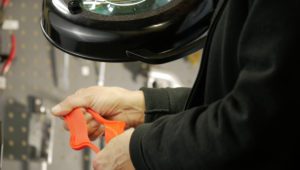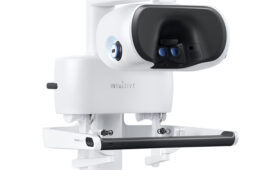Liquid silicone rubber (LSR) parts are used in a wide variety of medical devices. The process of molding LSR shares many similarities with conventional injection molding, but there are a few notable differences.
Tony Holtz, Protolabs

(Image courtesy of Protolabs)
Liquid silicone rubber (LSR) or elastomeric parts are frequently used in the medical industry because they are strong and elastic with excellent thermal, chemical and electrical resistance. They maintain their physical properties at extreme temperatures and can withstand sterilization.
LSR parts are also biocompatible, so they work well for products that have skin contact. Examples of applications abound: surgical instruments, handheld devices, operating room equipment, cartridges, ventilators, pumps, monitors, implantable prototypes, medical device components and prosthetic components.
LSR molding has a great deal in common with conventional injection molding, but there are a few notable differences. Unlike thermoplastic resin, which is melted before injection, LSR is a two-part thermoset compound that is chilled before being injected into a heated mold and ultimately cured into a final part. Since LSR is a thermosetting polymer, its molded state is permanent. Once it is set, it can’t be melted again like a thermoplastic.
Designing parts for LSR and thermoplastics is also similar, but there are some LSR-specific guidelines to consider:
Dimensions
Part sizes are guided by press size. As an example, at Protolabs, we allow for a maximum LSR part size of 12 in. (304 mm) by 8 in. (203 mm) by 4 in. (100 mm) with depths no greater than 2 in. (50 mm) from any parting line. Note that deeper parts are limited to a smaller outline. Molding pressure can damage the mold itself as short and sharp mold geometries would break under extreme pressure. To allow for a certain amount of safety mold material, deeper parts must have smaller length and width. Our maximum surface area is 48.4 sq. in. (312 sq. cm.) and maximum volume is 13.3 cu. in. (217 cc).
Wall and rib thickness
LSR typically fills thin wall sections with minimal challenges, and walls as thin as 0.010 in. are possible, depending on the size of the wall and the location of adjacent thicker sections. Rib thickness should be 0.5 to 1.0 times the adjoining wall thickness. LSR is accommodating to variations in wall thickness and sink is almost nonexistent.
Shrink and flash
The shrink rate on LSR is fairly high with an expected tolerance of 0.025 in./in. LSR also tends to flash very easily during molding, in gaps as small as 0.0002 in., which can be reduced by incorporating additional features into the mold design.
Parting lines
Simplifying and minimizing parting lines in your design will help you get cleaner LSR parts as quickly as possible.
Undercuts
LSR can be molded to accommodate parts with undercuts, which are manually removed by a press operator.
Part ejection
Ejector pins are normally not used during LSR molding due to the flashy nature of the material. Thus, parts should be designed so they can be retained on one-half of the mold when it is opened at the end of the molding cycle. The part is then manually de-molded, often with air assistance.
Tony Holtz is an applications engineer at Protolabs and has extensive knowledge and experience in both traditional and advanced manufacturing processes and material.
The opinions expressed in this blog post are the author’s only and do not necessarily reflect those of Medical Design and Outsourcing or its employees.



![A photo of the Medtronic GI Genius ColonPro polyp detection system flagging a potential sign of colon cancer during a colonoscopy. [Photo courtesy of Medtronic]](https://www.medicaldesignandoutsourcing.com/wp-content/uploads/2024/04/Medtronic-GI-Genius-doctors-268x170.jpg)
